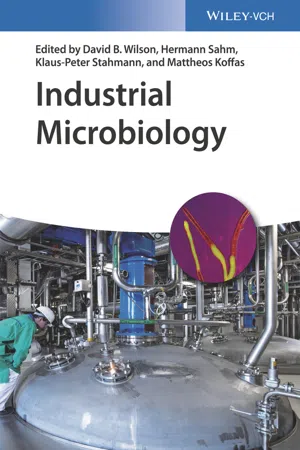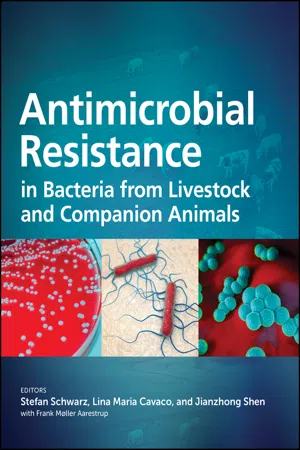Bactericidal Antibiotics
Bactericidal antibiotics are a class of antibiotics that have the ability to kill bacteria. Unlike bacteriostatic antibiotics, which only inhibit the growth and reproduction of bacteria, bactericidal antibiotics directly target and destroy bacterial cells. This makes them particularly effective in treating severe bacterial infections and in situations where a rapid reduction in bacterial population is necessary.
6 Key excerpts on "Bactericidal Antibiotics"
- eBook - ePub
Bacterial Pathogenesis
A Molecular Approach
- Brenda A. Wilson, Malcolm Winkler, Brian T. Ho(Authors)
- 2019(Publication Date)
- ASM Press(Publisher)
...There are more specific terms for antimicrobials that selectively act on a particular type of microbe: antibacterials or antibiotics for bacteria; antifungals for fungi (molds or yeasts); antiparasitics for protists, worms, or other parasites; and antivirals for viruses. A key concept in antimicrobial therapy is the difference between microbicidal and microbiostatic compounds. Antimicrobial compounds that kill the microbe above a certain dose are called microbicidal. Others, called microbiostatic compounds, merely stop or slow the growth of the microbe, but do not kill it. Similarly, antibacterial compounds that kill bacteria are called bactericidal, while bacteriostatic compounds only stop or slow the growth of bacteria. With bacteriostatic agents, the bacteria are not killed and can frequently recover once the antibiotic is no longer in use (referred to as tolerance). In patients with an intact immune system, bacteriostatic compounds can be very effective because the defenses of the body only need a little help in slowing the growth of bacteria so that they can be eliminated from the body. In people with defective immune defenses, however, there is much greater reliance on the antibacterial compound to effect a cure. Bactericidal Antibiotics are often best for treating infections in such patients. At one time, the distinction between bactericidal and bacteriostatic compounds seemed clear-cut. Certain antibacterials were bacteriostatic, others were bactericidal. That is, the distinction resided in the properties of the antibacterial compound. It is now clear that properties of the bacteria can affect this distinction too. A good example of this is bacterial biofilms. Bacteria that form biofilms change metabolically into a less active state. Such bacteria are able to resist (i.e., tolerate) an antibiotic that would be bactericidal if the bacteria were dividing rapidly...
- eBook - ePub
- Kristian Stromgaard, Povl Krogsgaard-Larsen, Ulf Madsen, Kristian Stromgaard, Povl Krogsgaard-Larsen, Ulf Madsen(Authors)
- 2016(Publication Date)
- CRC Press(Publisher)
...They are not effective against viral infections like common cold, most sore throats, and the flu. (FDA, 2015). Bactericidal Antibiotics cause bacterial cell death. Bacteriostatic antibiotics inhibit bacterial growth without any loss in viability. Broad-spectrum antibiotics are active on a large number of bacterial species. Narrow-spectrum antibiotics are active against a small number of bacterial species. Antibiotic resistance is the acquired ability of bacteria to survive and multiply despite the presence of therapeutic levels of one or more antibiotics. Multidrug-resistant (MDR) is defined as acquired nonsusceptibility to at least one agent in three or more antimicrobial categories. Extensively drug-resistant (XDR) is defined as nonsusceptibility to at least one agent in all but two or fewer antimicrobial categories (i.e., bacterial isolates remain susceptible to only one or two categories). Pandrug-resistant (PDR) is defined as nonsusceptibility to all agents in all antimicrobial categories. Antimicrobial resistance mechanisms : Given the limited number of targets on which the known classes of antibiotics act, resistance mechanism are also well developed. The major types of clinically relevant resistance mechanisms are (1) modification of target structures/overproduction of target (2) enzymatic modification/inactivation of the antibiotic/elimination through the efflux pumps/decreased penetration of the antibiotic (3) bypassing a particular step in a pathway. Combination therapy involves the use of two or more agents that (1) inhibit different targets in different pathways (e.g., the cocktail of antituberculosis drugs [see Table 23.3 ]), (2) inhibit different steps in the same pathway (e.g., sulfamethoxazole/trimethoprim), and (3) inhibit the same target in different ways (e.g., streptogramins). 23.1.3 B ACTERIA AND THE N EED FOR N EW D RUGS Antibiotic resistance crept along ever since the wide and successful use of antibiotics...
- eBook - ePub
- David B. Wilson, Hermann Sahm, Klaus-Peter Stahmann, Mattheos Koffas, David B. Wilson, Hermann Sahm, Klaus-Peter Stahmann, Mattheos Koffas(Authors)
- 2019(Publication Date)
- Wiley-VCH(Publisher)
...8 Antibiotics and Pharmacologically Active Compounds Lei Fang 1, Guojian Zhang 1,2,3, and Blaine A. Pfeifer 1,2,3 1 University at Buffalo, The State University of New York, Department of Chemical and Biological Engineering, 904 Furnas Hall, Buffalo, NY, 14260‐4200, USA 2 Ocean University of China, Key Laboratory of Marine Drugs, Chinese Ministry of Education, School of Medicine and Pharmacy, Qingdao, 266003, People's Republic of China 3 Laboratory for Marine Drugs and Bioproducts of Qingdao National Laboratory for Marine Science and Technology, Qingdao, 266237, People's Republic of China CHAPTER MENU 8.1 Microbial Substances Active Against Infectious Disease Agents or Affecting Human Cells 8.2 β‐Lactams 8.3 Lipopeptides 8.4 Macrolides 8.5 Tetracyclines 8.6 Aminoglycosides 8.7 Claviceps Alkaloids 8.8 Perspectives 8.1 Microbial Substances Active Against Infectious Disease Agents or Affecting Human Cells 8.1.1 Distribution and Impacts Small molecule natural products have had a powerful impact on human health and follow‐up commercial development. In this chapter, a heavy emphasis will be placed on those small molecules that possess antibiotic activity, a capability that has particularly impacted modern medicine, in addition to alternative therapeutic activities associated with these same types of compounds. A common definition of an antibiotic (derived from “antibiosis,” which was first used by Vuillemin in 1889) is a chemical substance produced by a microorganism that can kill or inhibit the growth of other microorganisms. More broadly, an antibiotic may be any small molecule with antimicrobial activity. Microorganisms have developed metabolic pathways devoted to natural products that possess antibiotic activity. Such pathways are referred to as secondary metabolism, distinct from primary metabolism in that the final compounds (secondary metabolites) do not contribute to the primary growth and maintenance goals of the microbial cell...
- Frank M. Aarestrup, Stefan Schwarz, Lina Maria Cavaco, Jianzhong Shen, Stefan Schwarz, Lina Maria Cavaco, Jianzhong Shen(Authors)
- 2018(Publication Date)
- ASM Press(Publisher)
...4 Mechanisms of Bacterial Resistance to Antimicrobial Agents Engeline van Duijkeren, 1 Anne-Kathrin Schink, 2 Marilyn C. Roberts, 3 Yang Wang, 4 Stefan Schwarz 2 INTRODUCTION With regard to their structures and functions, antimicrobial agents represent a highly diverse group of low-molecular-weight substances which interfere with bacterial growth, resulting in either a timely limited growth inhibition (bacteriostatic effect) or the killing of the bacteria (bactericidal effect). For more than 60 years, antimicrobial agents have been used to control bacterial infections in humans, animals, and plants. Nowadays, antimicrobial agents are among the most frequently used therapeutics in human and veterinary medicine (1, 2). In the early days of antimicrobial chemotherapy, antimicrobial resistance was not considered as an important problem, since the numbers of resistant strains were low and a large number of new highly effective antimicrobial agents of different classes were detected. These early antimicrobial agents represented products of the metabolic pathways of soil bacteria (e.g., Streptomyces, Bacillus) or fungi (e.g., Penicillium, Cephalosporium, Pleurotus) (Table 1) and provided their producers with a selective advantage in the fight for resources and the colonization of ecological niches (3). This in turn forced the susceptible bacteria living in close contact with the antimicrobial producers to develop and/or refine mechanisms to circumvent the inhibitory effects of antimicrobial agents. As a consequence, the origins of bacterial resistance to antimicrobial agents can be assumed to be in a time long before the clinical use of these substances...
- eBook - ePub
- Michael J. Neal(Author)
- 2020(Publication Date)
- Wiley-Blackwell(Publisher)
...38 Antibacterial drugs that inhibit cell wall synthesis : penicillins, cephalosporins and vancomycin The structures of the penicillins (top left) and cephalosporins (top right) share the common feature of a β‐lactam ring (B), the integrity of which is essential for antimicrobial activity. Modification of groups R 1 and R 2 has resulted in many semisynthetic antibiotics, some of which are acid resistant (and orally active), have a wide spectrum of antimicrobial activity or are resistant to bacterial β‐lactamases. Other β‐lactams have been developed that are resistant to β‐lactamases (bottom left). The penicillins (left) are the most important antibiotics * ; the cephalosporins (right) have few specific indications. The β‐lactam antibiotics are bactericidal. They produce their antimicrobial action by preventing the cross‐linkage between the linear peptidoglycan polymer chains that make up the cell wall, e.g. by a pentaglycine bridge (). This action is because a part of their structure () resembles the d‐alanyl‐d‐alanine of the peptide chains of the bacterial cell wall. Benzylpenicillin was the first of the penicillins and remains important, but it is largely destroyed by gastric acid and must be given by injection. Phenoxymethylpenicillin has a similar antimicrobial spectrum, but is active orally. Many bacteria (including most staphylococci) are resistant to benzylpenicillin because they produce enzymes (β‐lactamases, penicillinase) that open the β‐lactam ring. The genetic control of β‐lactamases often resides in transmissible plasmids (Chapter 37). Some penicillins, e.g. flucloxacillin, are effective against β‐lactamase‐producing staphylococci. Gram‐negative, but not Gram‐positive, bacteria possess an outer phospholipid membrane that may confer penicillin resistance by hindering access of the drugs to the cell wall...
- eBook - ePub
Antibiotic Resistance
Mechanisms and New Antimicrobial Approaches
- Kateryna Kon, Mahendra Rai(Authors)
- 2016(Publication Date)
- Academic Press(Publisher)
...Bacteriocins are a good option against drug-resistant pathogens such as P. aeruginosa, E. coli, methicillin-resistant Streptococcus aureus, penicillin-resistant Streptococcus pneumoniae, and M. tuberculosis, because these AMPs have high potency (acting at picomolar and nanomolar concentrations) and specificity. 28, 91 Bacteriocins as a source of new antibiotics have the advantages of diversity, specific targets, being considered safe (food grade), the ability to act synergistically with antibiotics, and reduced cell toxicity. However, it has been pointed out that depending on their size, they may be susceptible to proteolytic enzymes and some may become toxic to mammalian cells, which are drawbacks. 92 Several studies indicate that bacteriocins present great potential in the clinical area and as therapeutic agents because they can be used as substitutes for antimicrobial agents or in combination therapy with traditional antibiotics; this is due to their high activity against pathogenic microorganisms and their stability. 28, 93 Some in vivo studies in animal models such as mice have shown that bacteriocins can be a potential therapeutic agent against recurrent infections by M. tuberculosis, Streptococcus pyogenes, S. aureus, and S. pneumoniae. 28 The direct use of bacteriocin-producing microorganisms such as Lactobacillus spp., Bifidobacterium spp., and nonpathogenic E. coli may be more effective for pathogen bacterial control than the use of pure bacteriocins...





